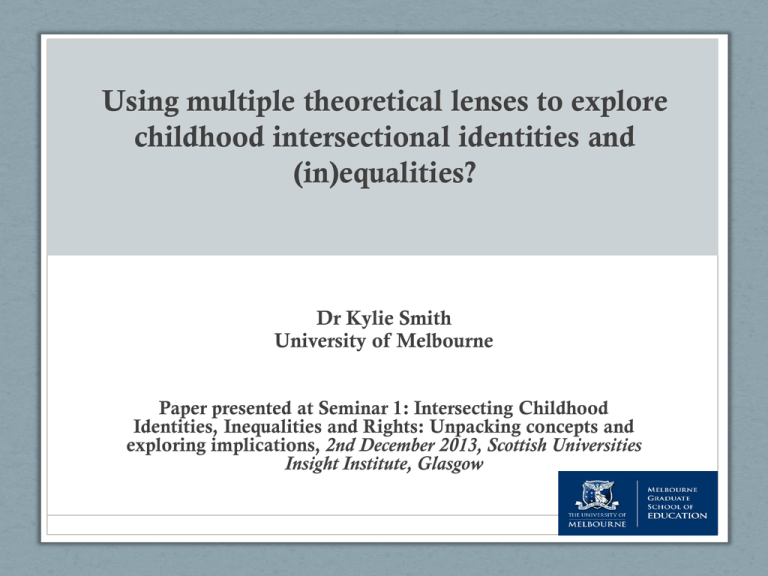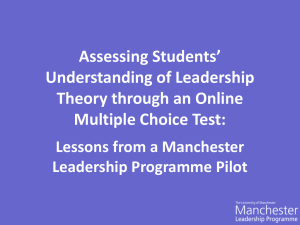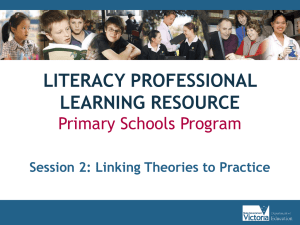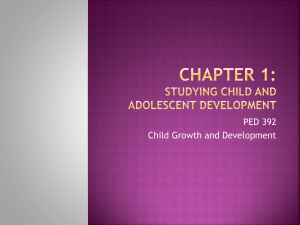Using multiple theoretical lenses to explore childhood intersectional
advertisement

Using multiple theoretical lenses to explore childhood intersectional identities and (in)equalities? Dr Kylie Smith University of Melbourne Paper presented at Seminar 1: Intersecting Childhood Identities, Inequalities and Rights: Unpacking concepts and exploring implications, 2nd December 2013, Scottish Universities Insight Institute, Glasgow Identity • Identity is not fixed but changeable • Identity is formed in and through discourse and therefore choices are limited or made possible through discourse. • • Identity is actively performed, not passively given ‘Categories’ of identity intersect and interconnect Gender Ability Religion Culture Sexuality Class Race Preschool children’s understandings of cultural and racial diversity project • What relationships exist between preschool children’s understandings of cultural and 'racial' diversity and their own gender, class and ethnic identities? • What factors influence preschool children's cultural and 'racial' understandings over time? • How can these relationships and understandings best be theorised? • What are the implications of what has been learnt for early education curricula? Conceptual understandings of children • Children are competent meaning makers who have valid and important knowledge about their worlds. • Children not only have the capacity to be active researchers. • Children have a right to be consulted in matters that affect them. Methodology • Self-portraiture and portraiture of friends • Observation – structured and unstructured • Ethnographic feedback • Child interviews • Stories with Diversity or Persona Dolls. Gender/”Race” and the Girls choice of Pseudonyms • 65% of girls in the project used female popular culture icons as their pseudonym. • Barbie, Barbie Princess, Fairy, Fairy Princess. Drawing on different theoretical perspectives Critical Race theories Biological theories Feminist poststructuralist theories Socialisation theories Reflection • So what theories would you draw on? • What theories do you always draw on? • What theories do you never draw on? • Why? Fractured/Missed (Mis)connections, (Dis)connections: Vietnamese-Australian girls, identities, and whiteness. • Can you tell me what colour your skin is? • What colour are your eyes? • Can you tell me what colour your hair is? • What colour are your lips? • What colour is your nose? “Girls will be girls?” • Our reading was that Barbie 2 and Barbie 3 were “doubly” connected to whiteness. They had chosen pseudonyms that connected them to proto-feminized whiteness and in naming skin colour as white. Diversity/Persona dolls • Which doll looks most like you? • Do you know anyone who looks like this doll? Can you tell me about them? • Which doll would you be friends with or play with? • Which doll would have the most friends? Critical race theories • Drawing from critical race theories we argue that the popular icons chosen by the girls reinforced protofeminized white identities through the fantasy images that normalize embodied feminized beauty as seductively white and heterosexual. For all the girls in our study, the proto-feminized popular culture icons that they accessed provided them with “white standards of gender” that persistently denied the possibility of desirable beauty and pleasurable girlhood being “ethnically other” or outside of whiteness. Exploring diverse theories that may not be dominate ‘early childhood’ theories • Critical race theory suggests that racism operates much more widely, often through the routine, mundane activities and assumptions that are unquestioned by most practitioners and policymakers, e.g. through the design of the curriculum, the operation of certain forms of assessment, and the selection and training of teachers who overwhelmingly replicate dominant cultural norms and assumptions about race and racial inequity (David Gillborn & Gloria LadsonBillings, 2010, p.40) Reflection • What theories would you draw on? • What theories do you always draw on? • What theories do you never draw on? • Why? • How does this fit within the Scottish context? These questions matter because they will effect how you undertake research, develop policies, develop and implement pedagogy and how you reinforce or disrupt dominate discourses that privilege or silence diverse identities. Questions • How do we support young children to share the realities of their identities and how they perform them? • How do we bring modern and postmodern theories together rather than competing to support equity and inclusion work? • How do we challenge unified, singular image of childhood and children as innocent and in need of protection within the classroom and society to recognise the intersectionality of identities and the gendered, sexualised, racialised, and classist discourses children are living and contributing to? • How do we mentor researchers, policy makers and educators who consult with children about the realities of inclusion and exclusion in their everyday lives and deal with what children say when we don’t want to hear? • How do we develop policies and training that encourage educators to draw on multiple theoretical perspectives to rupture singular unified images of the child and support the multiplicity of children’s identities? • How do we make theories more accessible for educators?






